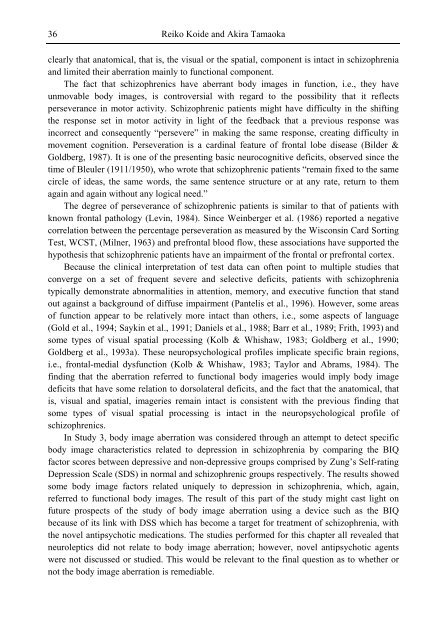Schizophrenia Research Trends
Schizophrenia Research Trends
Schizophrenia Research Trends
- No tags were found...
You also want an ePaper? Increase the reach of your titles
YUMPU automatically turns print PDFs into web optimized ePapers that Google loves.
36Reiko Koide and Akira Tamaokaclearly that anatomical, that is, the visual or the spatial, component is intact in schizophreniaand limited their aberration mainly to functional component.The fact that schizophrenics have aberrant body images in function, i.e., they haveunmovable body images, is controversial with regard to the possibility that it reflectsperseverance in motor activity. Schizophrenic patients might have difficulty in the shiftingthe response set in motor activity in light of the feedback that a previous response wasincorrect and consequently “persevere” in making the same response, creating difficulty inmovement cognition. Perseveration is a cardinal feature of frontal lobe disease (Bilder &Goldberg, 1987). It is one of the presenting basic neurocognitive deficits, observed since thetime of Bleuler (1911/1950), who wrote that schizophrenic patients “remain fixed to the samecircle of ideas, the same words, the same sentence structure or at any rate, return to themagain and again without any logical need.”The degree of perseverance of schizophrenic patients is similar to that of patients withknown frontal pathology (Levin, 1984). Since Weinberger et al. (1986) reported a negativecorrelation between the percentage perseveration as measured by the Wisconsin Card SortingTest, WCST, (Milner, 1963) and prefrontal blood flow, these associations have supported thehypothesis that schizophrenic patients have an impairment of the frontal or prefrontal cortex.Because the clinical interpretation of test data can often point to multiple studies thatconverge on a set of frequent severe and selective deficits, patients with schizophreniatypically demonstrate abnormalities in attention, memory, and executive function that standout against a background of diffuse impairment (Pantelis et al., 1996). However, some areasof function appear to be relatively more intact than others, i.e., some aspects of language(Gold et al., 1994; Saykin et al., 1991; Daniels et al., 1988; Barr et al., 1989; Frith, 1993) andsome types of visual spatial processing (Kolb & Whishaw, 1983; Goldberg et al., 1990;Goldberg et al., 1993a). These neuropsychological profiles implicate specific brain regions,i.e., frontal-medial dysfunction (Kolb & Whishaw, 1983; Taylor and Abrams, 1984). Thefinding that the aberration referred to functional body imageries would imply body imagedeficits that have some relation to dorsolateral deficits, and the fact that the anatomical, thatis, visual and spatial, imageries remain intact is consistent with the previous finding thatsome types of visual spatial processing is intact in the neuropsychological profile ofschizophrenics.In Study 3, body image aberration was considered through an attempt to detect specificbody image characteristics related to depression in schizophrenia by comparing the BIQfactor scores between depressive and non-depressive groups comprised by Zung’s Self-ratingDepression Scale (SDS) in normal and schizophrenic groups respectively. The results showedsome body image factors related uniquely to depression in schizophrenia, which, again,referred to functional body images. The result of this part of the study might cast light onfuture prospects of the study of body image aberration using a device such as the BIQbecause of its link with DSS which has become a target for treatment of schizophrenia, withthe novel antipsychotic medications. The studies performed for this chapter all revealed thatneuroleptics did not relate to body image aberration; however, novel antipsychotic agentswere not discussed or studied. This would be relevant to the final question as to whether ornot the body image aberration is remediable.
















